
10 *Accidental* Inventions and Discoveries! (Part 1 of 2)
January 30, 2024
10 More *Accidental* Discoveries and Inventions?! (Part 2 of 2)
February 18, 2024“It is possible to fly without motors, but not without knowledge and skill.” – Wilbur Wright
Most people would consider 1903 to be the birth of aviation – the year that the Wright Brothers flew the world’s first *successful* heavier-than-air craft (after numerous mishaps, false starts, and broken gliders), but humans have been attempting to defy gravity for centuries, and the Wright Flyer was just the latest innovation in a series of pioneers (some more successful than others). Since then however, there have been a number of incredible advances throughout the 20th Century and beyond – from Charles Lindberg’s crossing of the Atlantic and Chuck Yeager breaking the sound barrier to the Space Shuttle Program and the advent of Drone Technology…
1. 1782: The Montgolfier Bros and the World’s First Hot Air Balloon

121 years before the Wright Bros, the Montgolfier Brothers launched the first hot air balloon in France, in 1782! During their first impromptu flight, the pair nearly died when they lost control of the ascending balloon and crashed hard when the fire died out. Roughly 80 years later, during the Civil War, Union and Confederate spies were using hot air balloons to coordinate troop movements and artillery.
2. 1852: The First Dirigible: Henri Giffard’s Steam-Powered Airship!

Henri Giffard’s “Steam-Powered Airship” became the first official dirigible in 1852! German inventor, Ferdinand von Zeppelin, took the blimp design further with his rigid ‘Zeppelin’ design in 1899. In 1901, Alberto Santos-Dumont, a Brazilian aviator, became famous when he broke a world record for fastest blimp during a competition in Paris, France with his No. 6 Airship, topping out at a max speed of 25 miles-per-hour! Hydrogen-filled Zeppelins quickly became all the rage for commercial transport in the early 20th century, until about 1937 that is… when the Hindenburg went up in flames!

3. 1894-1896: Otto Lilienthal’s Gliders
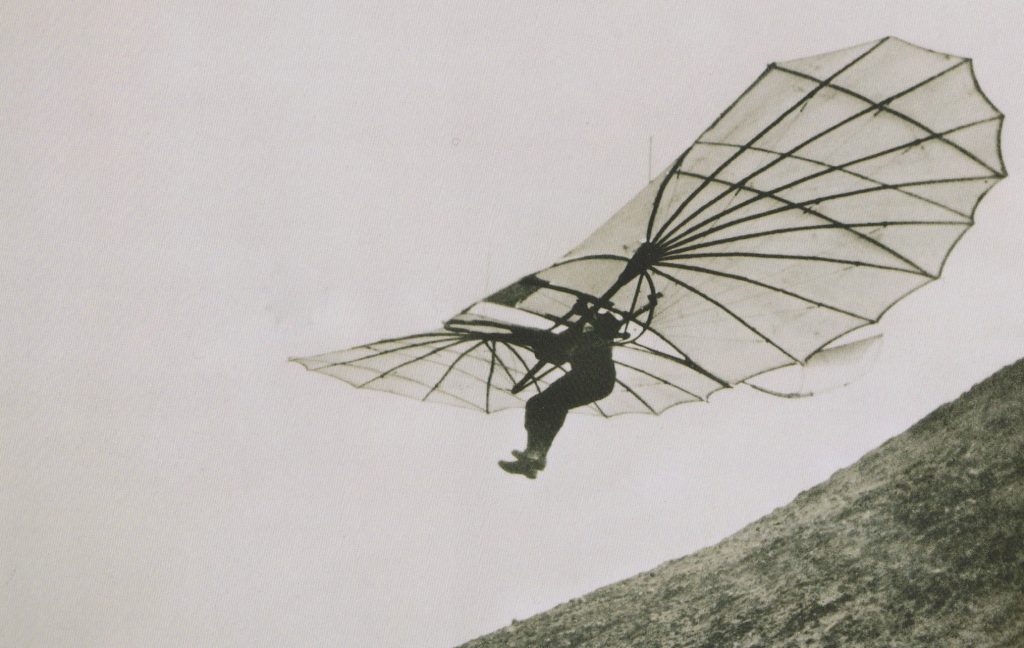
Another German aviator, Otto Lilienthal, made a series of successful winged-gliders, proving that (sustainable) heavier-than-air human flight was possible! Building off of Sir George Cayley’s aerodynamic research from the early 1800’s, Otto was soon known as “The Father of Flight” and even became an inspiration for The Wright Brothers. Unfortunately, his last test flight ended in tragedy, when his glider unexpectedly went into a nose-dive in 1896…
4. 1903: The Wright Brothers’ First Flight!

Orville and Wilbur Wright spent a number of years pursuing their dream to create the world’s first airplane. The two brothers from Dayton, Ohio overcame a series of failures and mishaps as they refined their “Wright Flyer” design through trial and error. The Wright Brothers changed history with their first successful test flight on December 14th, 1903, at Kill Devil Hills, in Kitty Hawk, North Carolina. The world’s first airplane – made of red spruce wood, with wings of muslin fabric, and a quaint 12-horsepower motor – lifted off for just 12 seconds, and travelled 120 feet!
Read all about it in my book, “Epic Fails – The Wright Brothers: Nose-Diving Into History”!

The Wright Flyer III, 1905
A few years later, in 1908, Orville Wright was also involved in the first plane crash when a propeller malfunction caused the craft to plummet to the ground, killing his passenger, Lieutenant Thomas E. Selfridge. A couple years later, in 1910, President Teddy Roosevelt took a brief flight aboard one of the Wright’s early planes, becoming the first American President to ride in an airplane! Decades later, when Neil Armstrong became the first man to walk on the moon in 1969, during Apollo 11, he brought a piece of the original wing and propeller from the original Wright Flyer from 1903!
5. 1914-1918: The Red Baron and the Bi-Planes of World War I
Like with any significantly advanced technology, man will always immediately find a way to weaponize it…

During the First World War (aka ‘The War to End All Wars’), all of Europe was caught up in a bloody standoff known as “Trench warfare”. This was the last war to use cavalry and the first one to use ‘aero-planes’ with bombs and machine guns strapped to them. A series of innovative bi-planes were developed by several countries as hundreds of courageous ace pilots fought in the skies above the brutal battlefields below. German pilot, Manfred von Richthofen soon became known as the infamous “Red Baron” for his incredible maneuvers in his crimson-red “Fokker” Tri-plane (lol), with a grand total of 80 air combat victories!
6. 1920-1937: Aviation Pioneers: Bessie Coleman and Amelia Earhart
In the earliest days of aviation, two incredible women made history, and paved the way for others to follow…

In 1920, Bessie Coleman travelled to France and became the first African-American woman to earn a pilot’s license. She later died tragically during an exhibition flight, aboard a Curtis JN ‘Jenny’, in Jacksonville, Florida, in 1926, after someone sabotaged the plane’s engine…
Amelia Earhart also first took flying lessons in 1920 and quickly became an icon for women in aviation, breaking through the glass ceiling and smashing a dozen records over the next couple decades. Then, during a bold attempt to circumnavigate the globe, Earhart and her Lockheed 10-E Electra mysteriously disappeared over the Pacific Ocean in 1937…
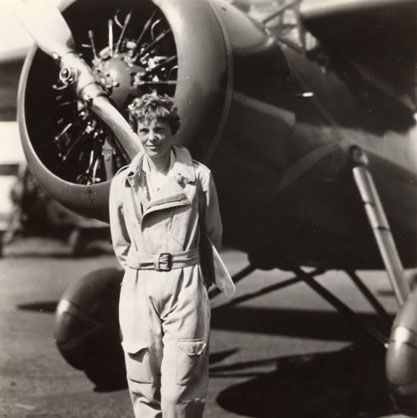
7. 1926-1933: Ford Trimotor – “The Tin Goose” (Commercial Airliner)

Henry Ford (yes, that Henry Ford – as in the creator of the Model-T automobile in 1908) decided to get into the aviation business in 1926. The Ford Motor Company teamed up with Stout Metal Airplane Co to create one of the first, mass-produced, 9-passenger commercial aircraft – right as early airlines were starting to spring up all around the world. The Ford Tri-Motor, commonly referred to as the “Tin Goose” was produced until 1933.
8. 1927: Charles Lindberg and the Spirit of St. Louis

Another significant aviation breakthrough happened in the 20’s, when a brave young man decided to challenge fate. Charles Lindberg was a 24-year-old airmail pilot whose mail route took him from St. Louis to Chicago. On May 20th, 1927, Lindberg pulled off the unthinkable, in his small, single-engine mono-plane, “Spirit of St. Louis”, taking off on a historic flight across the Atlantic Ocean, from New York to Paris!
After foregoing a parachute and a radio, the Spirit (a custom-built Ryan NYP, N-X-211, basically an old-school Cessna, with a Wright Company J-5C engine) lifted off from a runway in New York City, barely clearing the telephone wires, before it disappeared over the ocean’s horizon. 33 hours later, after fighting to stay awake throughout the long, dark flight into the unknown, Charles Lindberg arrived safely in France, landing to a cheering crowd of thousands. He had just successfully performed The First, Solo, (Non-Stop) Trans-Atlantic Flight!
9. 1933: The World’s First ‘Modern’ Airline: Boeing 247
The Boeing 247 was a game-changer in the aviation industry, first debuting in 1933.

This cutting-edge design incorporated a number of high-tech advances, such as: retractable landing gear, an autopilot, de-icing, and an all aluminum frame. One of the major drawbacks however was that it still only carried 10 passengers, 2 pilots, and a stewardess, making it less commercially viable. Regardless, it was a key stepping stone to the modern airliner. The 247 was later usurped by the Douglas DC-3 for the American Airlines contract in 1936 – which improved on every feature, and could even transport up to 32 passengers!
Boeing however continued to innovate, developing the 314 Clipper for Pan Am in 1938 – a large seaplane that was primarily used for Trans-Pacific luxury air travel between the United States, Hawaii, Australia, and “the Far East”.

10. 1939-1945: WWII Fighters, Bombers, and Aircraft Carriers

WWII once again pushed the science of aviation to it’s limits with a number of leaps and bounds. Air superiority had become a key component of warfare by the time Hitler’s Nazi Germany began to invade Poland, and many of the key battles throughout the war were decided by daring dog-fighter pilots, from the Battle of Britain to the Pacific War between the United States and the Empire of Japan.
Fighter planes became smoother and more agile – with the North American P-51D ‘Mustang’, the British Supermarine MKs 24 ‘Spitfire’, the Curtiss-Wright P-40 ‘Warhawk’, and the Japanese Mitsubishi A6M ‘Zero’, while the beefier American bombers like the Boeing B-17 ‘Flying Fortress’ and the B-29 ‘Superfortress’ ruled the skies. As the war evolved, it soon became apparent that naval Aircraft Carriers would become a deciding factor in the future of global conflict.

Boeing B-29: Superfortress
The war came to an abrupt end in 1945, soon after the “Enola Gay” (a B-29) dropped the first of two atomic bombs on Japan…
11. 1940-1942: The First Helicopter: Sikorsky R-4B / “The Hoverfly” (WWII)
Another WWII engineering marvel from 1942 was the invention of the helicopter!
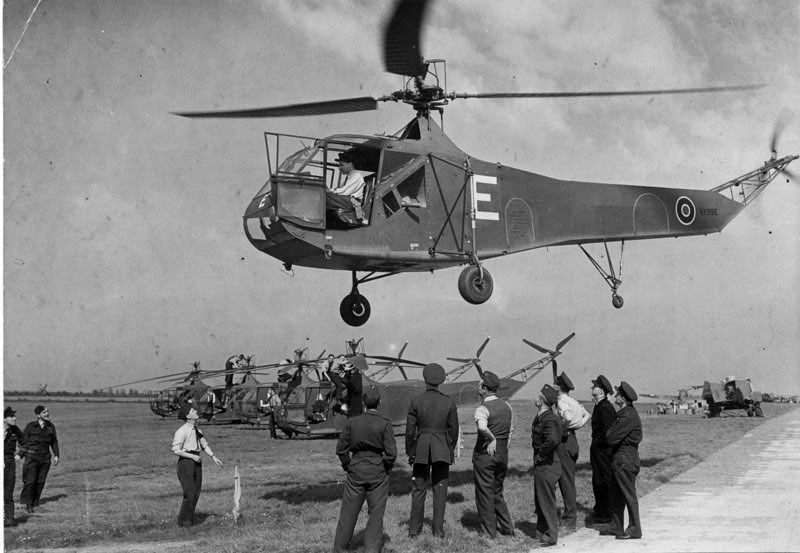
The Sikorsky R-4, or “The Hoverfly” was developed by a Russian-American inventor Igor Sikorsky, based on his prototype (The VS-300) which he first flew in 1940. Igor, who fled to the United States, during the Russian Revolution of 1917, was an engineer with a fascination with aircraft, eventually befriending Charles Lindbergh (see above), who likewise had connections with Henry Ford (also above). Inspired by the likes of Leonardo Da Vinci and others, Igor was determined to make the long hypothesized helicopter concept a reality!

The Proto-Copter (VS-300)
Commenting on his numerous brushes with death in early test flights, Sikorsky wrote, “I was ignorant that I was ignorant. This was ignorance squared, and it often led to disaster.” He later said, “At that time aviation was very dangerous… There was also the comforting realization that nearly all discoveries were preceded by numerous failures.” While they had no trouble getting the thing to go backwards or side to side, the most challenging design problem was actually getting it to fly forward!
The XR-4 was an instant success with the US Army, Coast Guard, Navy, and the Royal Navy. In fact, the USAAF ordered one hundred R-4Bs during the war. The first R-4 helicopter was deployed in combat during 1944. The commanding officer of the 1st Air Commando Group, Col. Philip G. Cochran wrote, “Today the ‘egg-beater’ went into action and the damn thing acted like it had good sense.”

The helicopter was revolutionary (no pun intended), with its unique ability to hover in place as well as to take off and land vertically. It quickly became one of the most versatile and commonly utilized aerial vehicles of the 20th century, employed by: news anchors, fire fighters, law enforcement, search and rescue, emergency medical transport, scientific expeditions, and so much more!
12. 1942-1947: The First Generation Fighter Jets (WWII)
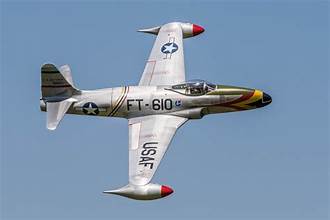
Another one of the most significant strides in aviation innovation also occurred in 1942, with the launch of the Lockheed P-80 aka the “Shooting Star”. Shortly after the German development of the BMW 003 turboshaft engine in 1940, several Allied companies scrambled to catch up and reverse-engineer the hypothetical “jet engine”. The P-80 was America’s first operational jet fighter, and saw limited combat at the end of WWII, in Italy. However, the Shooting Star was quickly outclassed by the Soviet MiG-15, prompting the US Air Force to develop the F-86 Sabre (one of the fastest sub-sonic aircraft of the time) in 1947 – both of which came into conflict during the Korean War.
13. 1942-1947: Howard Hughes’s “Spruce Goose” / H-4 Hercules 2 (WWII)
Glenn Curtiss flew the first amphibious aircraft as early as 1911 (with his Curtiss Model D). In 1921, Gianni Caproni tried (and failed) to make a 100-passenger “flying boat”. Soon after, seaplanes became commonplace throughout the 20’s and 30’s, but by far one of the most ambitious sea-worthy aircraft ever constructed was the colossal “Spruce Goose”, designed by famed business magnate, Howard Hughes.

Hughes was a wealthy tycoon who first came into the national spotlight as a Hollywood producer in the late 1920’s and early 30’s, directing “Hell’s Angels” (1930) and “The Outlaw” (1943) as well as producing movies like “The Conqueror” (1956) – which starred John Wayne as… Genghis Khan?! As one of the richest men in the world, Howard decided to pour a considerable amount of his enormous wealth into founding his own aircraft company in 1932, and spent the next several years breaking records with his innovative H-1 Racer. Then World War II kicked off, and the Hughes Aircraft Company became a major defense contractor for the US military.

In 1942, with the threat of German U-Boats, the US War Department was looking for alternatives to quickly transfer a large amount of troops and equipment across the ocean. Howard Hughes immediately got to work on designing the largest aircraft the world had ever seen. Because aluminum was in short supply, they had to build the flying cargo ship entirely out of wood! The project soon became known as ‘The Flying Lumberyard’ and ‘The Birch Bitch’. Costing tax payers around $23 million (in 1940’s money), the H-4 Hercules 2 prototype was an absolute behemoth: sporting a 320-foot wingspan (the largest ever built, until 2019!) – each with four propellers, and weighing around 200 tons! It was designed specifically to carry two 30-ton M4 Sherman tanks, along with 750 fully equipped soldiers!
Unfortunately, the gigantic “Spruce Goose” wasn’t finished until 1947… 2 years after the war had already ended. The massive plane only flew *once*, for a test flight on November 2nd, 1947. When called to speak to Congress about the incredibly late and over-budget project, Hughes stated on the record, “The Hercules was a monumental undertaking. It is the largest aircraft ever built. It is over five stories tall with a wingspan longer than a football field. That’s more than a city block. Now, I put the sweat of my life into this thing. I have my reputation all rolled up in it and I have stated several times that if it’s a failure, I’ll probably leave this country and never come back. And I mean it.”
In the later years of his life, after surviving four plane crashes (and buying multiple hotels in Las Vegas, on a whim), Howard Hughes suffered from a severe case of OCD, as well as an addiction to codeine, becoming a paranoid recluse, and (allegedly) died of kidney failure in 1976.
14. 1947: Chuck Yeager Breaks the Sound Barrier! – The Bell X-1

Chuck Yeager was a decorated ace fighter pilot during WWII, and after the war became one of the most renowned test pilots in the service, flying out of Edwards Airforce Base in California. On October 14th, 1947, Captain Yeager made history, becoming the first person to break the sound barrier! The Bell X-1 (aka “Glamorous Glennis”) was a prototype with an experimental rocket engine, launched mid-air from the bomb bay of a B-29 bomber. Before breaking the sound barrier though, Yeager broke two of his ribs during a horse accident, just two days before the flight! Chuck was in such overwhelming pain that he even had trouble sealing the hatch, mere minutes before his historic flight! The (bright orange) X-1 achieved Mach 1.05 at 45,000 feet above the Mojave Desert, becoming the first vehicle to travel at super-sonic speeds!

Gotta go fast!
This breakthrough immediately lead to the development of several “Second Generation” fighter jets with supersonic capabilities: The North American F-100 ‘Super Sabre’ (1953), The Lockheed F-104 ‘Starfighter’ (1954), and The Republic F-105 ‘Thunderchief’ (1955).
15. 1955: Lockheed U-2 Spy Plane (CIA / USAF)
The 1950’s saw a number of incredible technological leaps forward throughout the Cold War. One such development was the ‘top-secret’ Lockheed U-2 spy plane (code-named: “Dragon Lady”), a high-altitude reconnaissance aircraft, employed by the CIA and USAF to take strategic high-res photographs of enemy military bases to ascertain their capabilities. This incredible work of engineering can operate at an unfathomable altitude of 70,000 feet! (Note: 80,000 is considered ‘space’.)
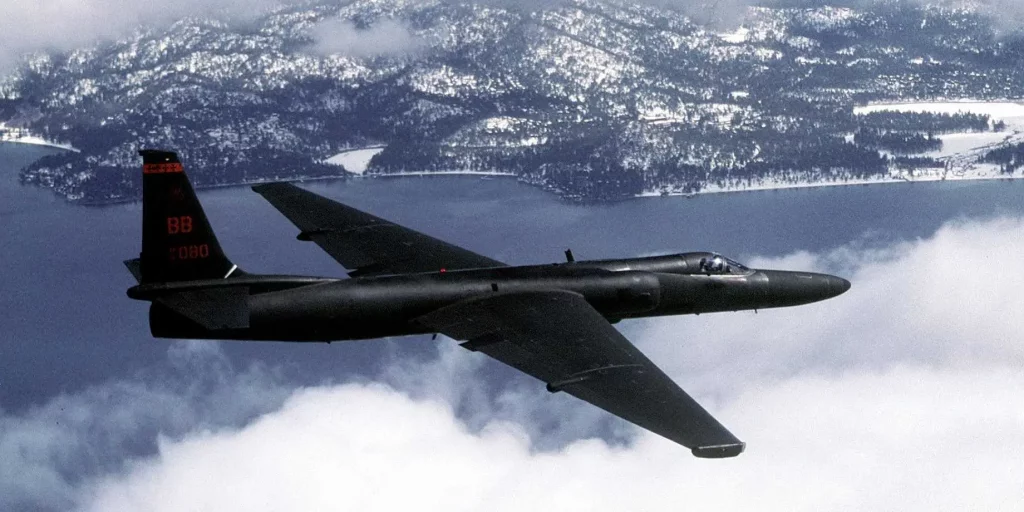
The rigorously trained pilots are required to wear space suits, and often risk decompression sickness, or worse. It’s said to be one of the toughest planes to operate, but remains one of the most effective intel tools used by the United States and its allies. These pilots were also operating over enemy territory during the height of the Cold War, so were supplied with cyanide capsules in the event that they were captured, to avoid being tortured by the KGB.

In 1956, Carmine Vito was on a top-secret U-2 survey mission, flying directly over the Soviet Union. His mouth went dry as he passed over Moscow, so he decided to grab one of the lemon cough drops that he’d dumped into his pocket before the flight. Unfortunately, someone had accidentally put his cyanide pill in the wrong pocket, causing him to casually pop the suicide pill into his mouth like a tic tac! Thankfully, he noticed instantly and spit it out, if he had bit down, he would have died instantly and crashed into Red Square, nearly triggering WWIII!
The whole U-2 operation was kept secret from the public until 1960, when a U-2, piloted by Gary Powers, was hit by a surface-to-air missile while on a recon mission over the USSR, and captured behind enemy lines. Just two years later, in 1962, Major Rudolf Anderson Jr. was also shot down, while piloting a U-2 over Cuba, during the Cuban Missile Crisis.
16. 1955-1975: VIETNAM aka “The Helicopter War”
Following Charles Kaman’s development of the experimental K-225 (YT50) – the first turbine-powered helicopter with intermeshing rotors, the US military went all in on the rotary revolution, in 1951…

Pictured: “Flight of the Valkyries” blaring non-stop
Throughout the Vietnam War, the US was forced to rely heavily on helicopters, due to the jungle terrain of the region, earning it the nickname ‘the Helicopter War’. These included: The ‘Huey’ (Bell UH-1 Iroquois) – a versatile chopper used for med-evacs and platoon transport, The Bell 209 / AH-1G “Cobra” Attack Helicopter (Codename: “The Snake”) – a flying arsenal of missiles, machine guns, and grenade launchers, The Boeing CH-47 Chinook – a twin-rotor cargo helicopter that could lift 46,000 pounds, and The Sikorsky HH 3E (aka “The Jolly Green Giant”).

Following Vietnam, these legendary choppers went on to influence the development of the Boeing AH-64 “Apache” and the Sikorsky UH-60 “Black Hawk” – both of which were instrumental during Operation Desert Storm (1991, Iraq).
17. 1957: Dawn of the Jetliners: The Boeing 707 (Pan Am Airlines)
Once again, Boeing changed the course of aviation history in 1957, with the introduction of the Boeing 707 – the first *successful* commercial airliner with jet-engines!

This now iconic swept-wing quad-jet was developed for commercial use by Boeing, utilizing the same jet-engine design techniques that were first developed for military contracts during and after WWII. In 1958, Pan Am Airlines introduced the brand new ‘jetliner’ at a ceremony attended by President Dwight D. Eisenhower. There were a number of variants on the 707, that could hold between 140 and 189 passengers comfortably. The 707 was later followed up by the 727 tri-jet in 1963, the 737 twin-jet in 1967, and in 1969, they unveiled the double-decker Boeing 747 “Jumbo Jet” – which could carry a total of 366 passengers!
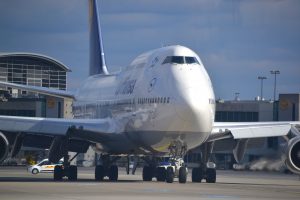
The Boeing 747: “Jumbo Jet”!
The 737 is still heavily in use today with Southwest, United, Delta, and American Airlines, among others, with a whopping 11,660 planes produced, and over 184 million flights as of 2013!
18. 1959-1968: North American X-15 – Hypersonic Rocket (USAF / NASA)
Following in the footsteps of Chuck Yeager – A. Scott Crossfield, former Naval officer and test pilot, became the first man to travel *twice* the speed of sound in 1953 – clocking Mach 2 (approx. 1,290 mph) in the Douglas D-558-2 Skyrocket! With over 99 test flights under his belt, Crossfield left NACA (the predecessor to NASA) to work for North American Aviation, one of the leading aerospace manufacturers at the time (now a part of Boeing). Scott Crossfield was heavily involved in the design and testing of one of the most daunting undertakings in the history of aviation: The X-15 – a test vehicle with the potential capability to break Mach 5: hypersonic speeds!

First introduced in 1959, deployed from a WWII B-52 Bomber, the North American X-15 was a rocket-powered test vehicle that pushed the limits of what we ever thought possible. During a collaborative study between NASA and the Air Force, this engineering miracle proved to be invaluable in researching the technical limits and challenges faced by American astronauts in the early days of the space program, as well as gathering unprecedented scientific data on the Earth’s upper atmosphere. Crossfield himself flew 14 of the 199 high-risk test flights.
Several other courageous pilots risked their lives flying this incredibly powerful craft, including future astronauts: Neil Armstrong of 1969’s Apollo 11 (the first man to walk on the moon!) and Joe Engle, who later commanded two Space Shuttle missions. In 1963, Joe Walker became the first man to fly an airplane into space – reaching an altitude of 100 km or 62 miles! In 1967, Colonel William J. Knight pushed the program to it’s limits with an insane max speed of Mach 6.7 – roughly 4,520 miles-per-hour!

Of the 12 brave test pilots to successfully fly the X-15, Major Michael J. Adams was the only killed during a test flight, when he entered an uncontrolled hypersonic spin at 60,000 feet that tore the craft apart. He was posthumously awarded his well-earned astronaut wings.
19. 1964-1999: Lockheed SR-71 “Blackbird”
In response to the U-2 spy plane incidents, the US military was in need of a craft sleek enough to avoid radar detection, and fast enough to avoid surface-to-air missiles. Lockheed delivered the impossible with the SR-71 “Blackbird” !
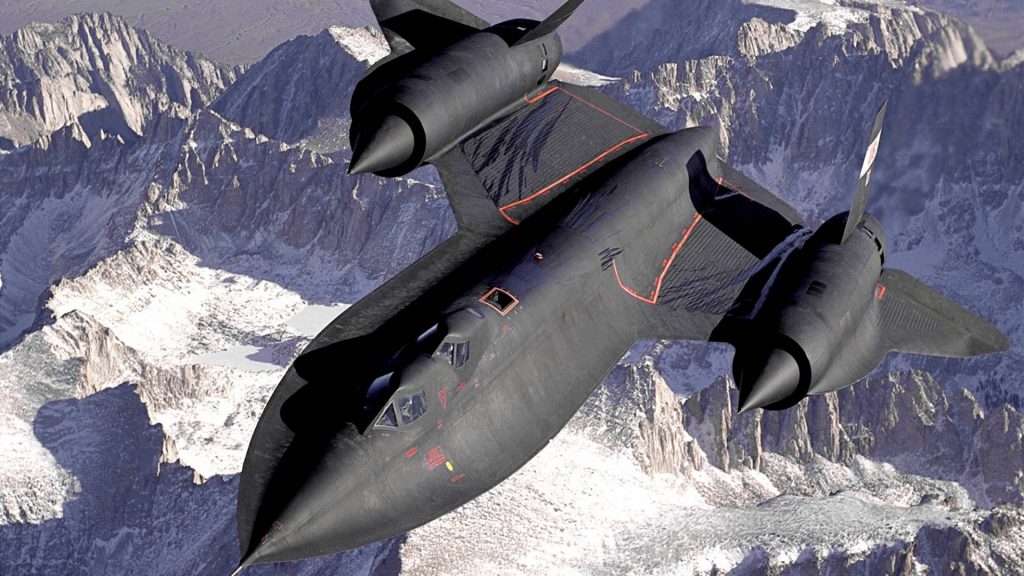
Loaned out to the US government from the X-Men
Developed by Lockheed throughout the 1950’s in complete secrecy at Area 51 in Nevada, the SR-71 was / is the fastest (non-rocket) airplane ever built! Officially completed in 1964, the “Blackbird” had a titanium metal frame, painted completely black to regulate heat, and had the ability to travel at sustained speeds of 3,000 feet-per-second, breaking Mach 3.2 at a horizontal altitude of 85,000 feet!
No ‘Blackbird’ was ever shot down by an enemy during a recon mission, by the time they were detected in hostile airspace, they were already gone. The plane was so fast, in fact, that the pilots had to be trained on different ways to navigate, because the usual landmarks would be lost in a blur of motion. In 1990, during one of the model’s final cross country flights – from LA to it’s final resting place at the Smithsonian’s Air and Space Museum in Washington DC – the 2,000 mile trip took only 67 minutes! Although it was officially retired in 1999, the SR-71 *still* (as of 2024) holds the world record for the fastest manned aircraft, first set back in 1976!
20. 1969-2003: Flight of the Concordes: A Supersonic Trans-Continental Airliner (SST)
On December 31st, 1968, the Soviet Tupolev Tu-144 prototype made history on it’s maiden flight, becoming the first *commercial* supersonic transport (SST), capable of reaching Mach 2! Just two months later, the Franko-British supersonic airliner, The Concorde was introduced!
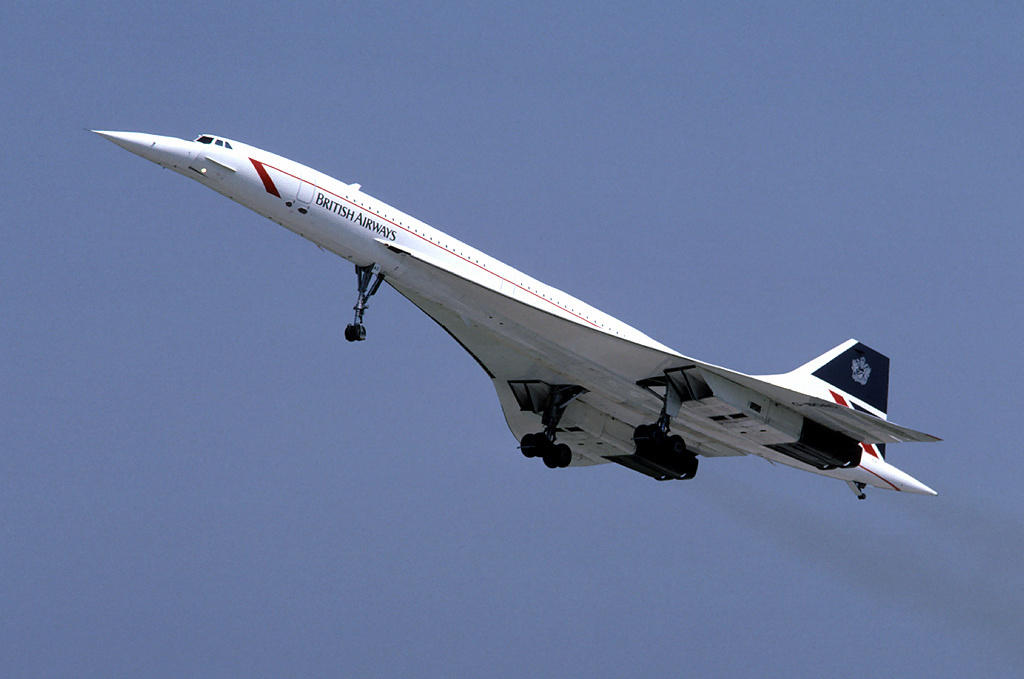
While the Russian Tupolev was quickly pulled from passenger service following a 1978 crash and was primarily used for transport purposes and cosmonaut training, and the Boeing 2707 SST was cancelled before it even went into production in 1971, the Concorde remained in service with British Airways and Air France from 1976 to 2003! To this day, the Concorde holds the record for the fastest Trans-Atlantic Flight ever (on February 7th, 1996) – from New York to London in: 2 hours, 52 minutes, and 59 seconds!
The Concorde remains one of the most impressive aircraft ever constructed, with: 4 Olympus Turbo-Jet engines, a sleek delta-shaped “tail-less” design, a unique “droop nose” for better landing visibility, and one of the first aircraft to incorporate avionic systems, hybrid circuits, and ‘Fly-By-Wire’ (FBW) controls! The supersonic plane could travel at an altitude of 60,000 feet with a comfortable cruising speed of Mach 2.04!

Unfortunately, dozens of delays and ballooning development costs (over 2 billion pounds in the 70’s!), with ticket prices costing $12,000 a person, as well as it being limited to Trans-Atlantic flights due to its incredibly powerful sonic booms, high fuel costs, and even higher maintenance costs, meant that it was never economically viable, not to mention increasing environment concerns. As a result, the Concorde never quite caught on with the mainstream public.
Despite having an incredible, unmatched, safety record for almost it’s entire history, tragedy struck on July 25th, 2000 when Air France Flight #4590 crashed shortly after takeoff, killing all 109 occupants as well as 4 civilians on the ground, when a fire broke out, after debris on the runway from another plane punctured its fuel tank, leading to a catastrophic explosion. It was the only fatal accident in the Concorde’s entire history. The remaining Concordes were retired from service just 3 years later, making commercial supersonic flight a relic of the past…
21. 1974-2024: The F-16 Fighter Jets (General Dynamics / Lockheed Martin) – Gen 4, 4.5
Whereas “Third Generation” fighter jets, like the bulky, twin-engine McDonnell Douglas F-4 Phantom II (1958), often prioritized speed and weaponry over maneuverability, the “Fourth Generation” fighters typically went for smaller, lighter, but far more agile, multirole combat aircraft. Even though Gen 3 Interceptors could fly above Mach 2, when it came to dogfighting, they frequently had a tough time dodging air-to-air missiles, which became a primary design consideration going forward. The Gen 4 fighters that followed also upgraded their computer guidance systems from analog to digital, along with a number of high-tech features like onboard radar and even infrared tracking sensors!
In 1974, General Dynamics introduced the F-16 Fighter Jet. With a max speed of Mach 2, it was the first aircraft built specifically to perform 9-G maneuvers! It even had the ability to super-cruise without the use of an afterburner. This was a quantum leap ahead of anything that had ever come before it, and was so successful that it’s still a key component of the US Air Force to this day.

*”Danger Zone” music intensifies*
The F-16 ‘Fighting Falcon’ is a single-engine supersonic, all weather, fighter / bomber. In addition to non-mechanical state-of-the-art electronic avionics, the F-16 is also equipped with ECM (Electronic-Counter-Measures) systems, a 20mm Vulcan cannon (capable of firing 6,000 rounds a minute!), 9-hardpoints (2 on the wing tips, 3 on each wing, and one under the fuselage), and can carry up to six heat-seeking Sidewinder missiles and / or radar-guided Sparrow missiles! However, one of the biggest design improvements incorporated was the polycarbonate “bubble” canopy, which gives the pilot a 360° visibility.
Now produced by Lockheed Martin, the F-16 has since gone on to become the most common fixed-wing aircraft used in military service, being deployed by 26 nations around the globe. Other US fighter jets from this generation include: The F-14 Tomcat (1970 – featured in the 1986 ‘documentary’, “Top Gun”), The F-15 Eagle (1972), and the F/A-18F Super Hornet (1995). Many of these Fourth Generation fighters had their electronics upgraded significantly throughout the 80’s and 90’s as microchip processors became exponentially more advanced, giving them a significant edge – often dubbing the upgraded models as “Generation 4.5”.

Tom Cruise approves this message.
22. 1977: NASA Space Shuttle: Enterprise – Prototype Test Flight and Landing

First conceived of in 1968, and finally unveiled in 1976, NASA’s first prototype of the Space Shuttle was the OV-101 “Enterprise”. And yes, it was in fact named after the Starship Enterprise from the original “Star Trek” series! Enterprise played a key role in testing out the Space Shuttle’s plane-like landing capabilities in 1977, when it was launched from the back of a 747! The Space Shuttle Columbia became the first to launch into orbit in 1981.
After 135 missions, including deploying (and fixing) the Hubble Space Telescope and assembling the International Space Station (ISS), as well as two unfortunate incidents (The Challenger Disaster of 1986 and the Columbia Tragedy of 2003), the Shuttle program came to an end in 2011, with the final flight of the Space Shuttle Atlantis.
23. 1989-2007: The Bell Boeing V-22 Osprey (VTOL / STOL)

Since the introduction of the world’s first helicopter in 1940, aerospace engineers have desperately been trying to perfect an aircraft that could fly horizontally like a plane, but take off and land vertically (VTOL) like a helicopter. There were a number of somewhat hilarious false starts throughout the 20th Century, but the first truly successful VTOL aircraft was the Bell Boeing V-22 “Osprey”, which first flew in 1989.
After nearly two decades of trial and error, the Osprey became the world’s first production ’tiltrotor’ aircraft in 2007.
24. 1989-2000: The Northrop Grumman B-2 Spirit – “Stealth Bomber”
Arguably one of the most advanced aircraft ever conceived, the Northrop Grumman B-2 Spirit was a game changer. Developed and tested at the (once top-secret) Area 51 Air Force base aka “Groom Lake” (just north of Las Vegas, Nevada), along with its predecessor the F-117 Nighthawk (1981). Covered in black, anti-reflective paint, the B-2 “Stealth Bomber” is an ‘all-wing’, two-seater, with high-maneuverability, and low radar visibility – thanks in part to it’s aerodynamic “radar-absorbing, heat-resistant, carbon-fiber-reinforced polymer, titanium alloy” frame.

The B-2 Spirit is capable of carrying 40,000 pounds ordnance, including thermonuclear warheads, with two rotary launchers, from an altitude of 50,000 feet. To top it all off, this stealthy, sub-sonic, tailless, fixed-wing bomber has a range of nearly 7,000 miles, and is capable of mid-air refueling! B-2’s cutting-edge stealth tech inspired the “Fifth Generation” of Fighter Jets, namely the F-22 Raptor (1997), and the outrageously expensive F-35 Lightning II (2006). Northrop Grumman is now developing the latest replacement for the Stealth Bomber in 2032, the B-21 Raider!
25. 1994: The General Atomics MQ-1 / RQ-1 – “Predator Drone” (CIA / USAF)
These days, “Drones”, UAV’s (Unmanned Aerial Vehicles), or RPA (Remotely Piloted Aircraft) are practically ubiquitous around the world, but it all started (officially) in 1994, with the “Predator Drone” (The General Atomics MQ-1 / RQ-1).

First developed for the CIA in the 80’s to spy on foreign adversaries, the Predator drone was decked out in the latest surveillance technology. The drone was soon modified to deploy AGM-114 Hellfire missiles for the Air Force, and has since become an invaluable asset for espionage and covert air strikes against terrorist cells in the Middle East. It’s successor, the General Atomics MQ-1C “Gray Eagle” can operate at 25,000 feet, for 36 hours, with a range of 200 nautical miles, and can be operated remotely by multiple remote pilots, on the ground, working in shifts.
Decades since the introduction of military drones, much smaller (and more affordable) commercial drones, like the remote-controlled quad-copter, have since gone mainstream, to the point that Amazon is now developing an AI-powered MK30 delivery drone, set to debut… later this year?

Progress? *Nervous Laughter*
– Erik Slader
Be sure to check out the Epik Fails of History podcast, 10 Accidental Inventions and Discoveries (Part 1 of 2), 15 Early *Failed* Attempts at Flight, 20 of the Worst Aircraft Designs of All Time?, and my books: “The Wright Brothers: Nose-Diving Into History” and “The Race to Space: Countdown to Liftoff”!
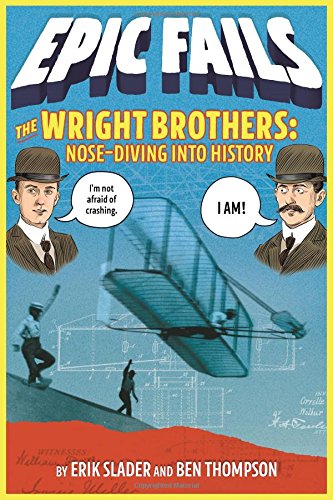
Sources:
https://en.wikipedia.org/wiki/Boeing_727
https://www.space.com/16623-first-powered-airship.html
https://en.wikipedia.org/wiki/Otto_Lilienthal
https://simpleflying.com/spruce-goose/
https://interactive.wttw.com/playlist/2018/03/20/bessie-coleman
https://en.wikipedia.org/wiki/Concorde#Accidents_and_incidents
https://www.history.com/news/helicopters-vietnam-war
https://simpleflying.com/boeing-247-legacy-vs-commercial-success-analysis/
https://www.bbc.com/future/article/20240119-the-f-16-at-50-why-its-still-in-demand
https://www.ctpost.com/local/article/First-flight-of-the-VS-300-5754303.php
https://en.wikipedia.org/wiki/Montgolfier_brothers#Hot_air_balloon_experiments,_1782
https://military-history.fandom.com/wiki/Jet_fighter_generations#Third-generation_jet_fighter_(1965-1975)
https://www.wright-brothers.org/Information_Desk/Just_the_Facts/Airplanes/Wright_Airplanes.htm
https://www.boeing.com/features/2023/06/22-fast-facts-on-the-bell-boeing-v-22-osprey
https://www.usatoday.com/story/graphics/2024/02/07/amelia-earhart-plane-found-maps/72453721007/
https://www.spaceline.org/united-states-manned-space-flight/us-astronaut-selection-drafts-and-qualifications/x-15-astronauts/
https://www.nationalmuseum.af.mil/Visit/Museum-Exhibits/Fact-Sheets/Display/Article/195868/sikorsky-r-4b-hoverfly/
https://en.wikipedia.org/wiki/General_Atomics_MQ-1_Predatorhttps://www.cnn.com/style/article/sr-71-blackbird-spy-plane-design/index.html
https://nationalinterest.org/blog/buzz/preparing-nuclear-war-air-force%E2%80%99s-b-2-stealth-bomber-has-test-dropped-new-bomb-36777
The Evolution of Helicopters: A Journey Through Time (400 B.C. to 2023)




